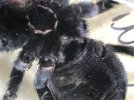-
Are you a Tarantula hobbyist? If so, we invite you to join our community! Once you join you'll be able to post messages, upload pictures of your pets and enclosures and chat with other Tarantula enthusiasts. Sign up today!
You are using an out of date browser. It may not display this or other websites correctly.
You should upgrade or use an alternative browser.
You should upgrade or use an alternative browser.
A.Hentzi Ventral Sexing
- Thread starter spike1119
- Start date
- Messages
- 1,744
- Location
- Queens, NY
- Messages
- 4,927
Thats a female 100%. You can see the crescent moon shape on her furrow and a mustache over her exuvium. I also see a slight opening.  Book lung spacing also indicates female.
Book lung spacing also indicates female.
- Messages
- 4,927
Thanks Casey! This is great news. We love our little murphy such a great T.
From underneath she looks like a G. pulchra, lol. Jet black. Haha
- Messages
- 99
- Location
- Anywhere in North America.
Spike -
My two cents: Almost surely a female. The plate between the two forward book lungs is called the epigynum. On males the epigynum tends to be relatively narrow, usually with the sides about the same distance apart as they are long, or giving the epigynum a lengthwise rectangular shape. And the sides of the epigynum are nearly parallel like so: | |
On females, the epigynum is very frequently wider than long, and the sides splay outward to make a definite trapezoidal shape like : / \
Lastly, on females the epigynal plate bulges outward, giving her a little pot belly. So if you pick her up and gently run your finger front to back over the epigynum, you'll feel a distinct little mound there. On the males it's nearly flat, with almost no noticeable mound or bulge.
In your photos, I can even SEE the bulge!
THE FINE PRINT...
Just as there is a great deal of variation among humans, so too is there variation among tarantulas. In some kinds these characteristics are not as obvious, especially in "slings" and smaller, hence my use of the word "almost" in the first sentence and other modifiers thereafter.
The GOLD STANDARD still remains thus:
If it produces an eggsac, it's got to be a female. If it develops clubbed pedipalps as it matures, it's got to be a male.
The next best way to sex your tarantula is to examine the shed exuvium (exoskeleton or skin) for the telltale internal signs of a female.
A distant third method involves trying to divine the tarantula's sex by examining the epigynal plate as we're doing here. For this option, always use lots of qualifiers like, "probably," "almost surely," "possibly," "maybe," and others.
Lastly, "Never bet the rent money!"
Are we having fun yet? Cheers,
My two cents: Almost surely a female. The plate between the two forward book lungs is called the epigynum. On males the epigynum tends to be relatively narrow, usually with the sides about the same distance apart as they are long, or giving the epigynum a lengthwise rectangular shape. And the sides of the epigynum are nearly parallel like so: | |
On females, the epigynum is very frequently wider than long, and the sides splay outward to make a definite trapezoidal shape like : / \
Lastly, on females the epigynal plate bulges outward, giving her a little pot belly. So if you pick her up and gently run your finger front to back over the epigynum, you'll feel a distinct little mound there. On the males it's nearly flat, with almost no noticeable mound or bulge.
In your photos, I can even SEE the bulge!
THE FINE PRINT...
Just as there is a great deal of variation among humans, so too is there variation among tarantulas. In some kinds these characteristics are not as obvious, especially in "slings" and smaller, hence my use of the word "almost" in the first sentence and other modifiers thereafter.
The GOLD STANDARD still remains thus:
If it produces an eggsac, it's got to be a female. If it develops clubbed pedipalps as it matures, it's got to be a male.
The next best way to sex your tarantula is to examine the shed exuvium (exoskeleton or skin) for the telltale internal signs of a female.
A distant third method involves trying to divine the tarantula's sex by examining the epigynal plate as we're doing here. For this option, always use lots of qualifiers like, "probably," "almost surely," "possibly," "maybe," and others.
Lastly, "Never bet the rent money!"
Are we having fun yet? Cheers,
- Messages
- 1,744
- Location
- Queens, NY
This is great, thank you Stan.Spike -
My two cents: Almost surely a female. The plate between the two forward book lungs is called the epigynum. On males the epigynum tends to be relatively narrow, usually with the sides about the same distance apart as they are long, or giving the epigynum a lengthwise rectangular shape. And the sides of the epigynum are nearly parallel like so: | |
On females, the epigynum is very frequently wider than long, and the sides splay outward to make a definite trapezoidal shape like : / \
Lastly, on females the epigynal plate bulges outward, giving her a little pot belly. So if you pick her up and gently run your finger front to back over the epigynum, you'll feel a distinct little mound there. On the males it's nearly flat, with almost no noticeable mound or bulge.
In your photos, I can even SEE the bulge!
THE FINE PRINT...
Just as there is a great deal of variation among humans, so too is there variation among tarantulas. In some kinds these characteristics are not as obvious, especially in "slings" and smaller, hence my use of the word "almost" in the first sentence and other modifiers thereafter.
The GOLD STANDARD still remains thus:
If it produces an eggsac, it's got to be a female. If it develops clubbed pedipalps as it matures, it's got to be a male.
The next best way to sex your tarantula is to examine the shed exuvium (exoskeleton or skin) for the telltale internal signs of a female.
A distant third method involves trying to divine the tarantula's sex by examining the epigynal plate as we're doing here. For this option, always use lots of qualifiers like, "probably," "almost surely," "possibly," "maybe," and others.
Lastly, "Never bet the rent money!"
Are we having fun yet? Cheers,



